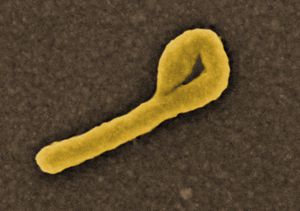Virus: Rozdiel medzi revíziami
(Importing text file) |
|||
| Riadok 1: | Riadok 1: | ||
:Slovak term: [[Slovenský termín]] | :Slovak term: [[Slovenský termín]] | ||
| + | [[File:Ebola_NIAID.jpg|right|thumb|Ebola Virus (by NIAID)]] | ||
# A sub-microscopic infectious agent that is unable to grow or reproduce outside a host cell (WHO 2009). | # A sub-microscopic infectious agent that is unable to grow or reproduce outside a host cell (WHO 2009). | ||
# A minute organism not visible by light microscopy (Symons et al. 2000). | # A minute organism not visible by light microscopy (Symons et al. 2000). | ||
Aktuálna revízia z 14:41, 22. september 2014
- Slovak term: Slovenský termín
- A sub-microscopic infectious agent that is unable to grow or reproduce outside a host cell (WHO 2009).
- A minute organism not visible by light microscopy (Symons et al. 2000).
- See also : Infectious disease.
Explanation
A virus is an obligate parasite dependent on nutrients inside cells for its metabolic and reproductive needs. It consist of a strand of either DNA or RNA, but not both, separated by a protein covering called a capsid (Symons etal. 2000).
Viruses consist of two or three parts : all viruses have genes made from either DNA or RNA (but not both), long molecules that carry genetic information; all have a protein coat called a capsid that protects these genes; and some have an envelope of fat that surrounds them when they are outside a cell. They are about 100 times smaller than bacteria (WHO 2009).
Example
A range of disease are caused by infections with viruses, ranging from influenza and measles to yellow fever, dengue and various forms of encephalitis (WHO 2009).
References
- Symons JM, Bradley LC and Cleveland TC (2000) The drinking water dictionary, American Water Works Association.
- WHO(2009) Health impact assessment glossary: E-learning modules.
